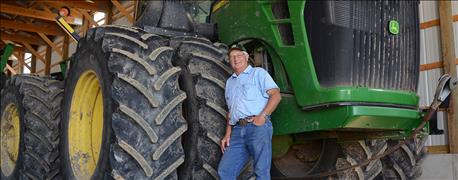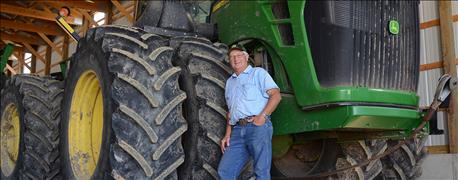November 7, 2016

The more things change, the more they remain the same.
In my 40 years of farming, I’ve seen the agricultural landscape change in so many ways. Like the farms of today, technology has gotten bigger and better; we’ve become more efficient with our limited natural resources; and we’re constantly improving our bottom lines through sharper management decisions.
And as documented by Prairie Farmer, many of the agricultural changes and improvements farmers have experienced since the mid-1800s are a direct result of Illinois farmers and innovators.

CONSISTENT: “Things aren’t all that different from when I planted my first acres in 1976,” says IFB President Rich Guebert from his Randolph County farm. “Farmers still strive to do their very best for their land and their animals; they still want to pass their farms on to the next generation; and they still feel an obligation to grow food that’s safe for themselves and their neighbors.” (Photo by Illinois Farm Bureau)
It was only after the introduction of John Deere’s first steel plow, which allowed farmers to finally cut through the tough prairie grass roots, that Illinois farmers could efficiently farm large swaths of prairie.
Cyrus McCormick’s reaper revolutionized harvest, allowing farmers to cut an acre of wheat in an hour and a half. And Joseph Glidden of DeKalb improved upon a previous version of barbed wire to get a patent for the fencing many producers now use today.
Add to the list items like the Conservation Reserve Program, global positioning systems in farm equipment, precision planting, cover crops, split-nitrogen application, water conservation practices, no-till farming, artificial insemination, genetically modified crops and gene sequencing in livestock, and you have farming practices that have evolved over generations to help make farmers competitive in the global market.
The more things change
But perhaps what’s more impressive than the changes we’ve made over the years are the changes we haven’t made.
In fact, things aren’t all that different from when I planted my first acres in 1976. Farmers still strive to do their very best for their land and their animals; they still want to pass their farms on to the next generation; and they still feel an obligation to grow food that’s safe for themselves and their neighbors.
Just like it was in the mid-1800s, farming is still an expensive and risky business. In 1850, it took families anywhere from four to 10 years’ worth of work, or about $1,000, to own or rent a farm and establish a successful enterprise.
Today, that number has increased exponentially, making it increasingly hard for young farmers to acquire land and equipment and start farming operations of their own.
But despite the challenges, farming is still a family affair, much like it was when the first settlers arrived in Illinois. Even though the number of farmers and farms has decreased while the size of most farms has increased, 97% of Illinois farms are still family-owned.
Starting with a meeting
Similarly, Illinois Farm Bureau has stayed close to its roots. In 1916, the Illinois Farm Bureau started with a group of farmers who met at the University of Illinois to discuss the need for education, better information and more effective farming practices.
Over the course of 100 years, the Illinois Farm Bureau has maintained the same vision, helping provide information and education for farmers, but also has evolved into an organization that is involved in passing legislation beneficial to farmers and lobbying lawmakers about agricultural issues.
And as we have for 100 years, we’re constantly looking for new ways to adapt our organization to a changing global marketplace, membership and farmer. As an organization, we’re working with our members to lay the foundation for 100 years more of representing farmers with our Future of the Organization project.
Essentially, we’re still the same organization of farmers working collectively to achieve goals for the greater good that we were 100 years ago.
I guess you could say that we, as an organization, have done well to follow the lead of Prairie Farmer, which is just 75 years our senior.
Prairie Farmer may have added websites, podcasts, blogs and farm shows in an effort to change with the times, but in keeping with tradition, the print magazine still remains a staple on many rural coffee tables. And as it should, Prairie Farmer has remained an Illinois-focused agricultural magazine for Illinois farmers.
Congratulations, Prairie Farmer, on 175 years of being devoted to Western agriculture, mechanics and education. Or, perhaps, since times have changed, just being devoted to farmers on the prairie.
Guebert is a Randolph County farmer and a Master Farmer who serves as president of the Illinois Farm Bureau.
You May Also Like




